Facts About the Different Types of Galaxy
There are four main types of galaxies: spiral, barred, elliptical, and irregular. While there are similarities, galaxies are individually unique so other types emerge in addition to the main ones.
- Galaxies come in all sizes. Dwarf galaxies host around 100 million stars. Though it is in the millions, this is nothing compared to giant galaxies which have more than one trillion stars.
- Among the main types, spiral galaxies are the most common. In fact, nearly 80% of the galaxies observed are in this category.
- There are two types of spiral galaxies: normal and barred spirals. Roughly two-thirds of spiral galaxies have bar structures.
- Elliptical galaxies have circular to elongated shapes. Galaxies of this type have older stars. Also, they are not active starbirth regions. When it comes to size, there are giant ellipticals and the more common dwarf ellipticals.
- Irregular galaxies have no definite shapes. They are neither spiral nor elliptical. Galaxies of this type are usually bright since they have lots of gas. That means they are active sites for star formation.
- Collision is a common event among galaxies. In fact, the Milky Way will collide with the Andromeda Galaxy a few billion years from now. The individual stars in galaxies are far apart so the Sun will not crash into another. These interactions will distort the galaxies’ shapes and will result in rapid new star formation.
- The Milky Way, a barred spiral, is mostly made up of dark matter. Dark matter is invisible. However, its presence was inferred by scientists because of the gravitational effects on galaxies that seem to be from an unseen source.
- The Sun takes 225 to 250 million years to orbit the center of the Milky Way. This is called a “cosmic year” or “galactic year.”
What Is A Galaxy?
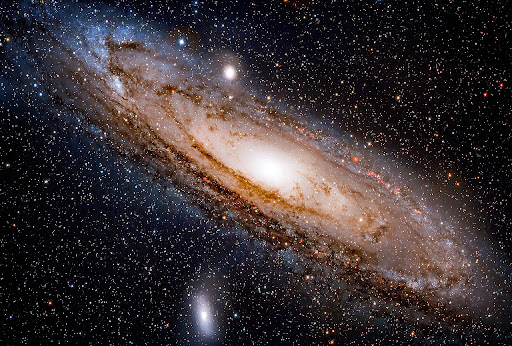
Each galaxy has its own collection of stars, planets, black holes, neutron stars, moons, nebulae, asteroids, comets, and dark matter. Our galaxy is a barred spiral galaxy and is called the Milky Way. It has large spiral arms with a bulging disk and bar of stars in the center.
Our galaxy, like our solar system, is in constant motion. The universe is made of different galaxies that are the basic units of the universe. Our universe has a large spectrum of diversity, as some galaxies are extremely complex and others quite simple.
More About Galaxies
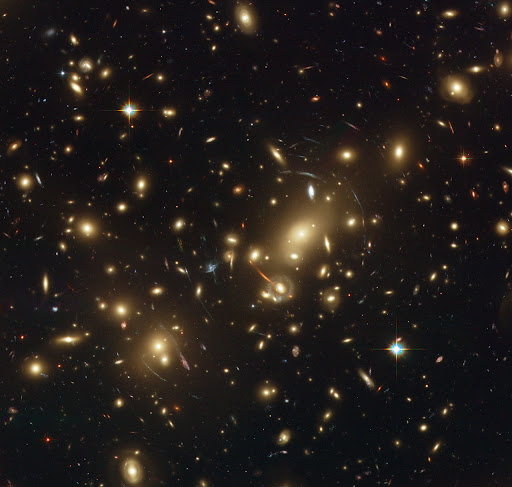
We can think of a galaxy the same way as we think of Earth. When we define our planet, we consider things such as gravity, the core, the atmosphere, and the surface that is composed of water and landmasses.
The planet is composed of different types of ecosystems. Depending on their location on our planet and their position relative to the Sun, these ecosystems range from hot and steamy to bitterly cold and blustery.
Just like there are dense populations of people, there are dense populations of stars. And just as our Earth is composed of a myriad of materials that are unique to Earth, each galaxy is composed of a mix of gas, dust, and stars that are unique to that galaxy. All these things are held together by gravitational forces.
Although there are many types of galaxies, just as there are different countries, each galaxy, like each country, is unique. There are many galaxies that exist in our universe, each one a spectacular collection of star systems and gas.
Our Home Galaxy: The Milky Way Galaxy
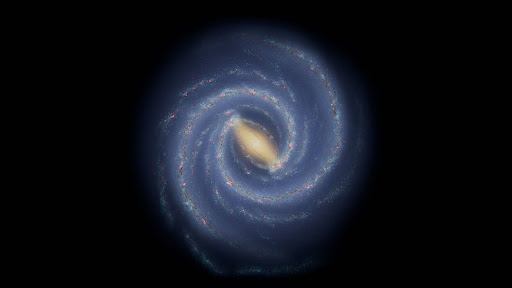
The Milky Way is the galaxy where the solar system is. It is a barred spiral type that is more than 150,000 light-years across. The Sun, which lights up the Earth and everything in the solar system, is just one of the 100 to 400 billion stars in this galaxy.
If there is one planet for every star, then there are as many stars in this galaxy, and even more. Also, about 17 million exoplanets in this galaxy lie in the habitable zone of their star systems.
A big part of the Milky Way galaxy is thought to be made up of dark matter. Its existence is inferred because of the gravitational effects on the galaxy from an unseen source. Scientists call this invisible source “dark matter.”
The Local Group is a group of galaxies where the Milky Way belongs. The biggest one in this group is the Andromeda galaxy, and the Milky Way is the second. Just like most of the galaxies, there is a supermassive black hole in the center of our galaxy, called Sagittarius A*.
Our Place in the Milky Way
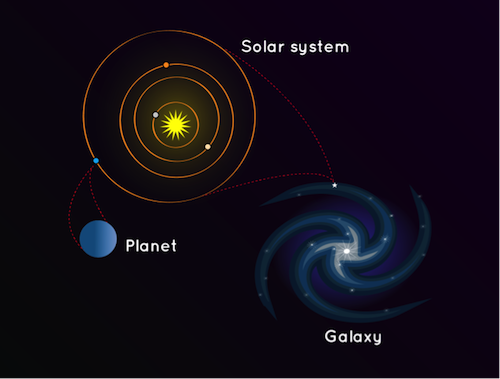
The Sun is one of the billions of stars in the Milky Way. Our solar system, together with the Earth and other planets, is just one of the many star systems as well.
Over millions of years, a galaxy forms moons, planets, comets, asteroids, stars, dust, nebulae, dark matter, and neutron stars. Black holes also exist in galaxies, a fascinating phenomenon that pulls in anything that gets too close.
Space is filled with emptiness, areas where nothing at all is present and galaxies are filled with empty space along with the other elements found in galaxies. Galaxies are in motion. Everything that is in the galaxy revolves around its center, just as our planets revolve around our Sun.
In our galaxy, the Milky Way, our solar system’s Sun is found on the outer portion of the Orion Arm, about 1/4 of the way in and nearly 3/4 from the central bulge.
The movement of all galaxies suggests that at one point in time they were all together at the same place. A big cosmical event happened, like the Big Bang, which caused the galaxies to move away from each other. They have continued on this path for millions of years, moving rapidly away from each other.
After many years of studying galaxies, Hubble recognized patterns and created the classification scheme discussed below.
Hubble’s Principal Schemes
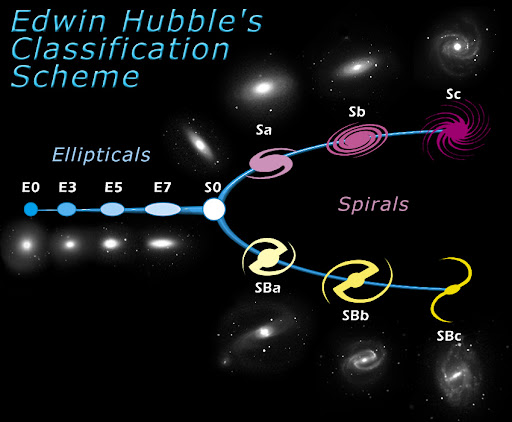
In 1926, Edwin Hubble created a classification scheme of the galaxies. The diagram is shaped like a tuning fork and is commonly called the Hubble Tuning Fork.
Hubble placed the different types of galaxies in a logical evolutionary order. The handle of the fork contains the elliptical galaxies, and on the two tines, he placed the spiral galaxies. Hubble determined that each type of galaxy had vast variations.
For elliptical galaxies, Hubble assigned values from E0 to E7 with E0 indicating an almost round elliptical, and E7 an elongated cigar-shaped elliptical. The last place on the handle is occupied by the first spiral galaxy and is designated S0.
Hubble saw a connection between some spiral galaxies and the elliptical galaxies. Because he sensed elliptical galaxies had a commonality with spiral galaxies, Hubble placed the S0 galaxy on the handle of the fork, in part because these have no arms, like elliptical galaxies.
At the top level of the Hubble classification, he placed spiral galaxies in the order of decreasing bulge and tightness of the arms: the tighter the galaxy, the larger the bulge. The scale assigns values Sa, Sb, and Sc, with Sa being the most tightly wound with the largest bugle.
On the bottom of the tuning fork handle, Hubble placed the barred spiral galaxies.
A barred spiral galaxy has arms and a central bulge, but in the center, the galaxy also has a bar of stars whose ends form the arms of the galaxy. Barred spiral galaxies are denoted SBa, SBb, and SBc and follow the same rules for placement as the regular spiral galaxies.
SBa represents very tightly wound galaxies with large bulging centers. SBc, on the other hand, has loosely wound galaxies with smaller bulges in the center.
Enter the Irregular Galaxies
Hubble found that certain types of galaxies did not fit neatly with his classification. Examples are dwarf galaxies and the nearby galaxies—the Magellanic Clouds. Although they are sometimes referred to as giant elliptical, these irregular galaxies are among the smallest in the universe.
When diagramming Hubble’s Tuning Fork, the irregular galaxies are placed between the two tines that hold the spiral galaxies. Hubble’s evolutionary theory termed the “a” type galaxies early and those categorized with “c” as late-term.
French astronomer Gérard de Vaucouleurs extended Hubble’s classification scheme. He added other factors to categorize galaxies and their morphologies. According to him, to better classify spiral galaxies, three characteristics should be considered: bars, rings, and spiral arms.
Hubble’s classification scheme is viewed as simplistic today but is still useful for introducing the basic concepts of the universe.
How Do Galaxies Form?
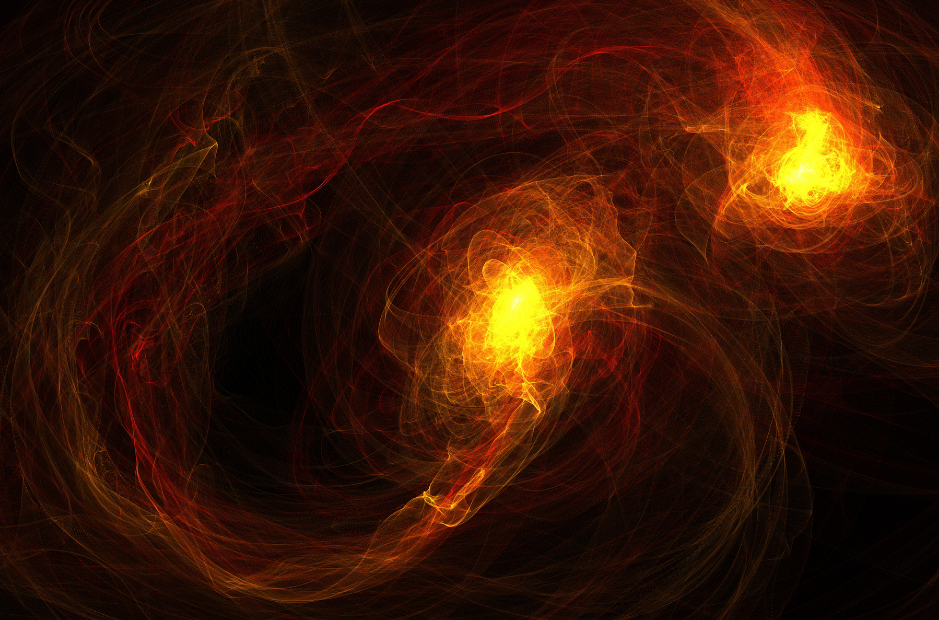
There is still so much to learn about galaxies and the universe as a whole. Galaxies formed billions of years before us. The Milky Way, for example, is believed to have formed around 13.5 billion years ago.
With that said, we can only take a look at how this process unfolds through computer simulations. Also, there are different theories on how galaxies came to be.
Scientists hold that the universe was born because of the Big Bang. According to this theory, the universe started as a hot single point that started to expand around 13.8 billion years ago.
As a result, the universe was filled with atoms of light elements like hydrogen and helium. These atoms clumped together and became denser in some areas. As they swirled, they became bigger and bigger until they collapsed because of gravity.
Stars were born as these clouds collapsed and the expansion continues. The collections of dust and dark matter collided with other clouds until they merged and became even bigger.
After the collisions, a new galactic core was formed. The stars started to settle into their new orbits around this new cloud. This is how galaxies are believed to have formed—a process that takes millions to billions of years to unfold.
Even today, the universe is still expanding and interacting with each other. In fact, the Milky Way is expected to collide with the Andromeda galaxy about 4.5 billion years in the future.
Types Of Galaxies – Four Galaxy Classifications
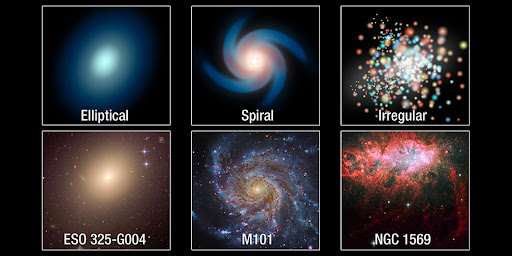
As discussed in the section on galaxy classifications, Hubble found four distinct types of galaxies: elliptical, spiral, spiral barred, and irregular.
Although there are different types, we also learned that each galaxy contains the same elements, but these are arranged differently for each type.
Just as every human is created with the same proteins that are configured uniquely, so are the galaxies uniquely configured with gasses, dust, stars, and other elements.
Spiral Galaxy – Types Of Galaxies
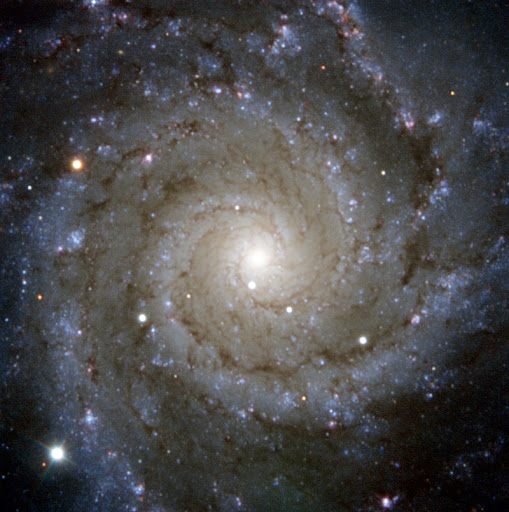
Spiral galaxies are easily identified by observing three components common to all spiral galaxies. A spiral galaxy has:
- Disk
- Bulge
- Halo
The center of the galaxy is like a nucleus, containing a sphere-shaped bulge that houses old stars and is devoid of dust and gas. The circular shape of the galaxy composes the disk. The arms of the spiral galaxy originate in the disk and are where new stars will form in a galaxy.
The sun in our galaxy is located in one arm and its stars are created in this portion of the galaxy, which contains the most gas in the galaxy. This area is rich in blue stars.
The halo is a spherical-shaped collection of old stars and clusters known as globular clusters found at the outer edge of the galaxy. The stunning view of Spiral Galaxy Messier 74 (above) from NASA taken with the Hubble telescope shows a bright bulge in the center with the arms spiraling outward.
When a spiral galaxy has no arms, S0, it is called lenticular. These galaxies are so similar to E7 that identifying them can be tricky. Lenticular galaxies also occur with a barred spiral and are classified as SB0.
Spiral galaxies are the most common galaxy of the known universe, comprising about 77% of all known galaxies.
The Andromeda Galaxy, the Pinwheel Galaxy, Triangulum Galaxy, Sunflower Galaxy, and the Sombrero Galaxy are some examples.
Andromeda Galaxy
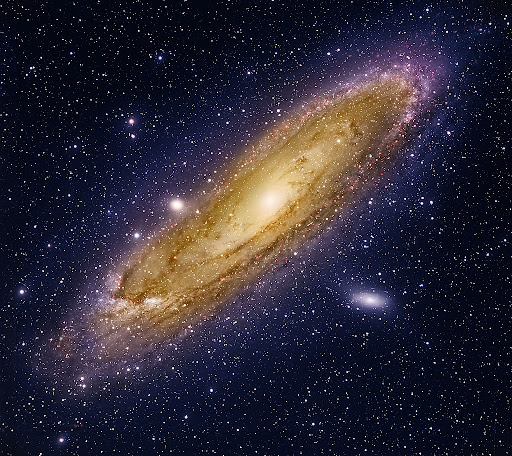
- Designation/s – Messier 31 (M31), NGC 224
- Type – Spiral Galaxy
- Constellation – Andromeda Constellation
- Apparent Magnitude – 3.44
- Size – 220,000 light years across
- Mass – 1,230 billion M☉
- Number of Stars – ~ 1 trillion
- Distance – 2.5 million light-years
The Andromeda Galaxy is an example of a spiral galaxy. Called before as the “Andromeda Nebula,” this deep-sky object changed our understanding of the universe. It proved that the Milky Way is not alone and there are many other galaxies out there.
Andromeda is the nearest large galaxy neighbor of the Milky Way. It is also called Messier 31 (M31) and NGC 224. The Andromeda galaxy spans about 220,000 light-years across and has around one trillion stars.
This galaxy is named after the Andromeda constellation, the area where it appears in our night sky. It is the largest member of the Local Group of galaxies, where our Milky Way also belongs.
Being our closest neighbor, the Andromeda Galaxy lies roughly 2.5 million light-years away from us. It has an apparent magnitude of 3.44, which means we can easily see it with the naked eye.
Pinwheel Galaxy
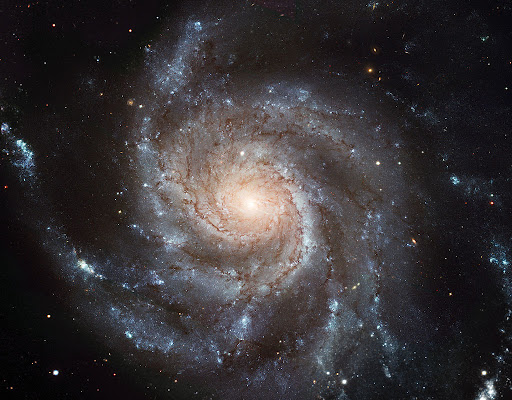
- Designation/s – Messier 101 (M101), NGC 5457
- Type – Spiral Galaxy
- Constellation – Ursa Major
- Apparent Magnitude – 7.86
- Size – ~170,000 light-years across
- Mass – ~100 billion M☉
- Number of Stars – ~ 1 trillion
- Distance – 21 million light-years
The Pinwheel Galaxy is a spiral galaxy in the northern constellation of Ursa Major. It was discovered in 1781 by Pierre Méchain and was designated Messier 101 in the Messier catalog.
This galaxy has a diameter of around 170,000 light-years and has around 1 trillion stars. There is not much star formation in the central bulge of the Pinwheel Galaxy. However, HII regions are abundant in its arms. These are areas where many stars are born.
The Pinwheel Galaxy has smaller satellite galaxies. So far, there are more than 3 supernovae events in M101. This is an example of a face-on spiral galaxy because we can see its arms and overall spiral shape. It lies around 21 million light-years away from us.
Triangulum Galaxy
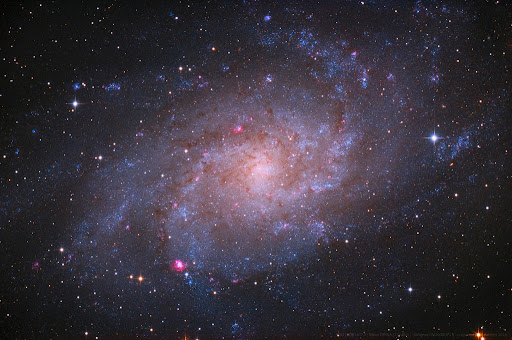
- Designation/s – Messier 33 (M33), NGC 598
- Type – Spiral Galaxy
- Constellation – Triangulum
- Apparent Magnitude – 5.72
- Size – ~50,000 light-years across
- Mass – ~50 billion M☉
- Number of Stars – ~40 billion
- Distance – 2.73 million light-years
The Triangulum Galaxy, also called Messier 33, is a spiral galaxy. It is located in the constellation of Triangulum in the northern sky. It is the third-largest member of the Local Group, after the Andromeda Galaxy and the Milky Way.
With an apparent magnitude of 5.72, we can see Triangulum Galaxy with the naked eye. Because of its shape, it is sometimes called the Pinwheel Galaxy, though this name refers to Messier 101.
The Triangulum galaxy spans about 50,000 light-years across in diameter. It is roughly 60% as big as the Milky Way. New star formation is taking place in the spiral arms of this galaxy. One H II region, in particular, is NGC 604, a very bright star-forming site.
Sunflower Galaxy
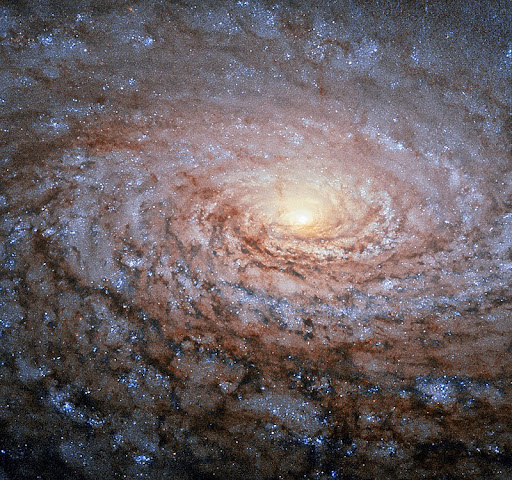
- Designation/s – Messier 63 (M63), NGC 5055
- Type – Spiral Galaxy
- Constellation – Canes Venatici
- Apparent Magnitude – 9.3
- Size – ~98,000 light-years across
- Mass – ~140 billion M☉
- Number of Stars – ~400 billion
- Distance – 29.3 million light-years
The Sunflower Galaxy is a spiral galaxy located in the constellation of Canes Venatici. The spiral arms of this galaxy are not continuous, so it is also considered a flocculent spiral galaxy. Rather, they are patchy and not very well-defined.
Radiation is detected in the arms of the Sunflower Galaxy which are traces of newly formed young stars. This galaxy was discovered by Pierre Méchain in 1779. It is not visible to the naked eye but can be seen using small telescopes.
Sombrero Galaxy
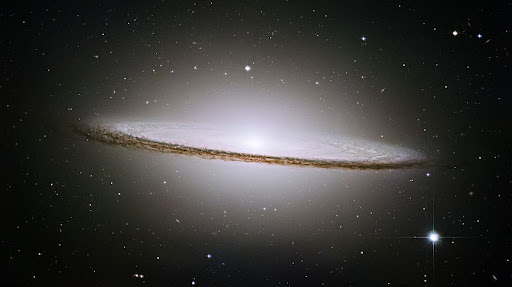
- Designation/s – Messier 104 (M104), NGC 4594
- Type – Spiral Galaxy
- Constellation – Virgo
- Apparent Magnitude – 8
- Size – ~50,000 light-years across
- Mass – ~800 billion M☉
- Number of Stars – ~100 billion
- Distance – ~29 million light-years
The Sombrero Galaxy looks interesting from our point of view because it looks edge-on. With that said, that means we can see it on the side. It is located around 29 million light-years away.
The Sombrero Galaxy has spiral arms and a bulbous core. It is abundant in globular clusters, estimated to be around 2,000. A supermassive black hole is believed to be at the center of this galaxy.
With an apparent magnitude of 8, this galaxy is not visible to the naked eye but can be easily spotted with an amateur telescope.
Barred Spiral Galaxy – Types Of Galaxies
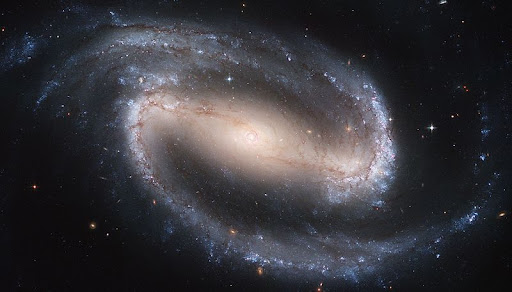
Barred spiral galaxies share the same features and functions as regular spiral galaxies. However, they also have a bar of bright stars that lie along the center of the bulge and extend into the disk.
The bright bulge has very little activity and contains mostly older, red stars. The bar and arms have lots of activity including star formation.
While the classification for barred spirals is the same as it is for regular spiral galaxies, the bar must be considered as well. Short bars correlate to tighter galaxies and will be included in the designation SBa. SBb galaxies have longer bars and SBc are the longest.
Most astronomers now agree that the Milky Way is a barred spiral galaxy. Other examples are Messier 109, NGC 1300, NGC 4921, and NGC 1073.
Messier 109
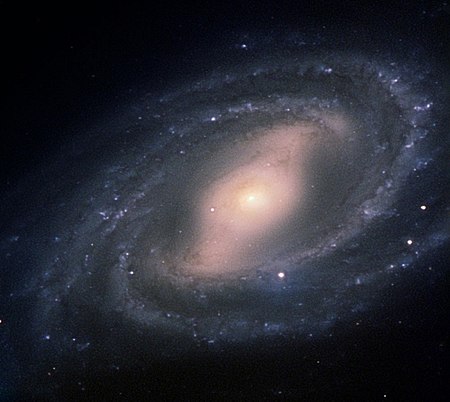
- Designation/s – Messier 109 (M109), NGC 3992
- Type – Barred Spiral Galaxy
- Constellation – Ursa Major
- Apparent Magnitude – 9.8
- Number of Stars – ~1 trillion
- Distance – ~60 million light-years
Messier 109 is a barred spiral galaxy discovered by Pierre Méchain. A supernova was observed from this galaxy in 1956. It has three satellite galaxies that are believed to be affecting this galaxy in some way.
Around the central bar of M109 is a weak inner ring. Lying around 60 million light-years away, we cannot see this galaxy with the naked eye.
NGC 1300
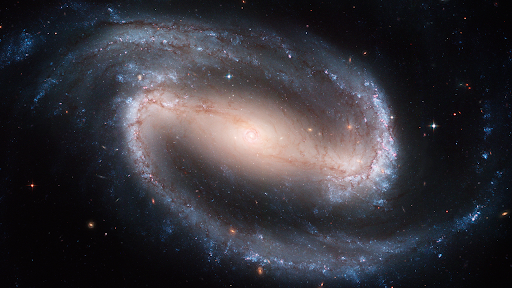
- Designation/s – NGC 1300
- Type – Barred Spiral Galaxy
- Constellation – Eridanus
- Apparent Magnitude – 11.4
- Size – ~110,000 light-years across
- Distance – ~61 million light-years
NGC 1300, nearly face-on as viewed by the Hubble Space Telescope, is a perfect example of a barred spiral galaxy. It is characterized by a central bar with spiral arms that spring from it. With a diameter of more than 100,000 light-years, it is roughly half the Milky Way’s size.
John Herschel discovered the galaxy NGC 1300 in 1835. This galaxy most likely has a central black hole. It is located in the constellation of Eridanus, the celestial river.
NGC 4921
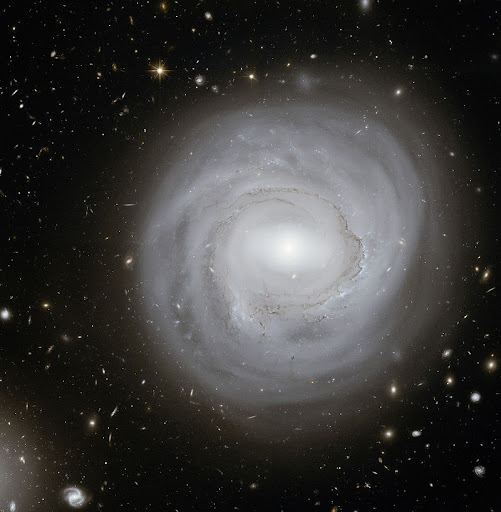
- Designation/s – NGC 4921
- Type – Barred Spiral Galaxy
- Constellation – Coma Berenices
- Apparent Magnitude – 13.04
- Size – ~209,400 light-years across
- Distance – ~320 million light-years
NGC 4921 is a unique-looking barred spiral galaxy. It is described as an “anemic” type because of its low surface brightness. The arms and disk of this galaxy are not much different when it comes to apparent color.
There is a low rate of star formation in NGC 4921. A supernova was observed in this galaxy in 1959. It is located in the Coma Berenices constellation, some 320 million light-years away.
NGC 1073
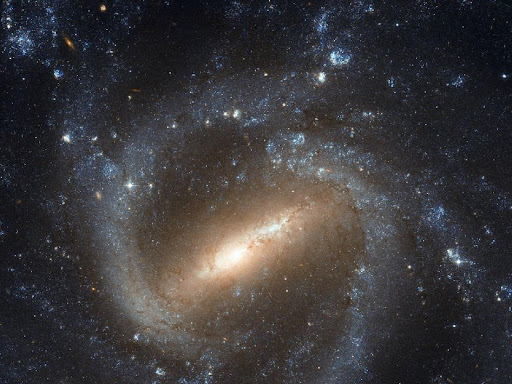
- Designation/s – NGC 1073
- Type – Barred Spiral Galaxy
- Constellation – Cetus
- Apparent Magnitude – 11.5
- Size – ~80,000 light-years across
- Distance – ~55 million light-years
NGC 1073 is another example of a barred spiral galaxy. We can spot it in our night sky in the area where the constellation of Cetus the Sea Monster. This galaxy is believed to be around 80,000 light-years across.
Galaxy NGC 1073 is not visible to the naked eye but we can easily see it using a mid-size telescope. It is roughly 55 million light-years away from us.
Elliptical Galaxy – Types Of Galaxies
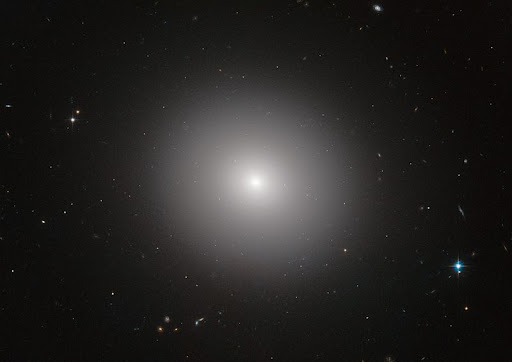
Elliptical galaxies can be recognized by their elongated spherical shape and their lack of a nucleus or bulge at the center. Although there is no nucleus, the galaxy is still brighter in the center and becomes less bright toward the outer edges of the galaxy.
Stars, gases, and other materials are spread throughout the elliptical galaxy. An elliptical galaxy can be nearly round or long and cigar-shaped.
It is believed that a great deal of the mass in an elliptical galaxy is due to the presence of a central black hole. These galaxies have very little activity. They contain mostly old stars of low mass because there is not enough gas and dust needed to form new stars.
Examples of elliptical galaxies include the IC 1101, Messier 59, Messier 60, Maffei 1, and Messier 49.
IC 1101
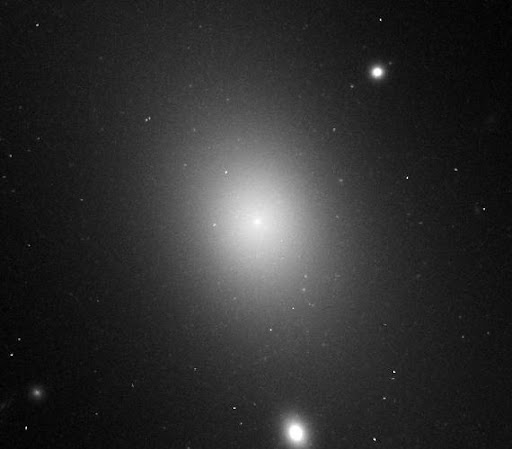
- Designation/s – IC 1101, A2029-BCG
- Type – Elliptical Galaxy
- Constellation – Virgo
- Apparent Magnitude – 14.73
- Size – ~6 million light-years across
- Mass – ~2,500,000 billion M☉
- Number of Stars – 100 trillion
- Distance – ~1 billion light-years
IC 1101 is very massive. This is an elliptical galaxy that is considered a supergiant. In fact, it is one of the largest, if not the largest, galaxies known. It is located in the constellation of Virgo.
While there are about 100-400 billion stars in the Milky Way, there are about 100 trillion stars in IC 1101. Blue stars are not very abundant in this galaxy, which means it is not undergoing rapid star formation. Many of its stars have yellow hues which indicate that they are already old.
A supermassive black hole is believed to be at the center of this very large galaxy. Estimated to be around 40–100 billion times the mass of the Sun, making it one of the largest black holes known to date.
Messier 59
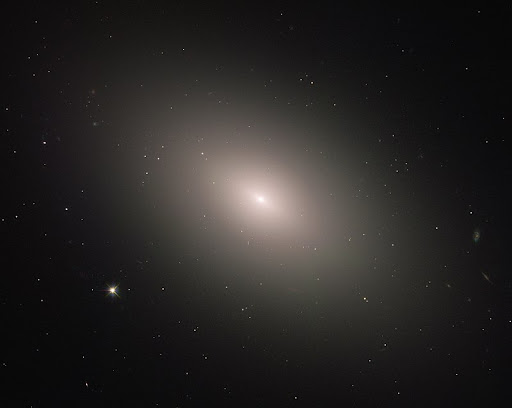
- Designation/s – Messier 59, NGC 4621
- Type – Elliptical Galaxy
- Constellation – Virgo
- Apparent Magnitude – 9.8
- Distance – ~60 million light-years
Messier 59 is a large elliptical galaxy that is located in the direction of the Virgo constellation. It is part of the Virgo cluster, a large group with more than 1,000 member galaxies.
Elliptical galaxies are known to be mostly populated with old stars. However, Messier 59 is showing interesting characteristics because of the presence of young stars near its core. This star-forming feature makes it different from other elliptical galaxies.
Messier 60
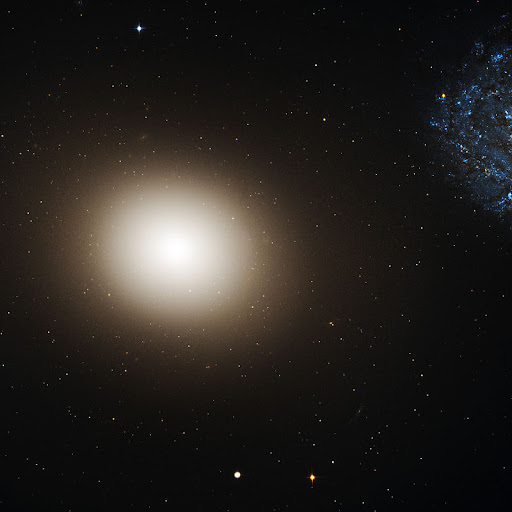
- Designation/s – Messier 60 (M60), NGC 4649
- Type – Elliptical Galaxy
- Constellation – Virgo
- Apparent Magnitude – 9.8
- Size – ~120,000 light-years across
- Mass – ~1 trillion M☉
- Distance – ~54 million light-years
Messier 60 is the third-largest galaxy in the Virgo cluster. This elliptical galaxy is roughly 120,000 light-years across. Also, we can fit about 1 trillion suns in this galaxy, that’s how massive it is.
Johann Gottfried Keohler discovered M60 in 1779. We can see this galaxy using small to large telescopes. The Hubble telescope captured images of this galaxy together with NGC 4647. It is not yet clear if the two are really interacting as there are no signs of star-formation yet. The two are together called Arp 116.
Maffei 1
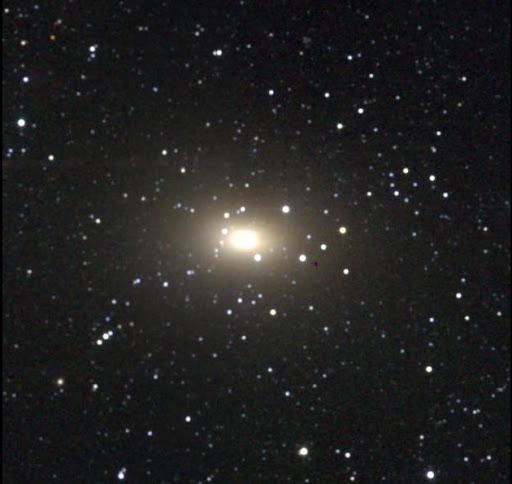
- Designation/s – Maffei 1
- Type – Elliptical Galaxy
- Constellation – Cassiopeia
- Apparent Magnitude – 11.14
- Size – ~75,000 light-years
- Distance – ~10 million light-years
Maffei 1 is a close giant elliptical galaxy to us. However, it was only discovered in 1968 because of the dusty central band of the Milky Way that makes it hard to see past it. It lies in the constellation of Cassiopeia the Queen.
Most of the stars in Maffei 1 are already old but the small blue nucleus indicates star formation activity. This galaxy was discovered by Paolo Maffei using infrared astronomy. He also discovered a spiral galaxy nearby it, called Maffei 2.
Messier 49
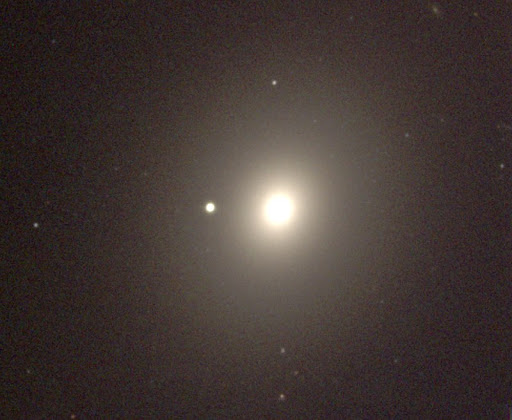
- Designation/s – Messier 49 (M49)
- Type – Elliptical Galaxy
- Constellation – Virgo
- Apparent Magnitude – 9.4
- Distance – ~56 million light-years
Messier 49 was discovered in 1771 by Charles Messier. As an elliptical galaxy, it is mostly featureless. X-ray emissions are detected from this galaxy which may be coming from a supermassive black hole. This black hole is estimated to be nearly 600 million times the solar mass.
There are roughly 6,000 globular clusters in the Messier 49 galaxy. Unlike open clusters, it is composed of older stars. This galaxy lies roughly 56 million light-years away in the Virgo constellation.
Irregular Galaxy – Types Of Galaxies
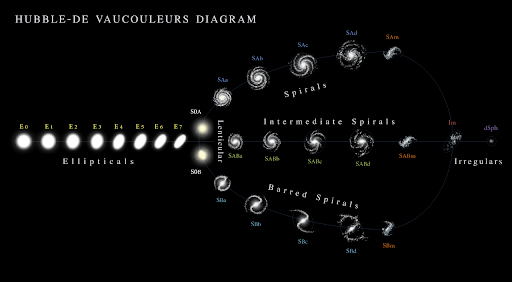
Irregular galaxies are composed of gasses, dust, stars, nebulous formations, neutron stars, black holes, and other elements common to all galaxies. Irregular galaxies are named so because they have no definite shape. However, like all galaxies, they are in constant motion, moving outward and away from the center of our universe.
Irregular galaxies are divided into two classifications: Im and I0.
Im galaxies occur most often among irregular galaxies and may show a trace of the spiral galaxy arms. I0 galaxies are completely random and can be called chaotic in nature. The Magellanic clouds that border our own Milky Way Galaxy are examples of Im galaxies. Approximately 20% of the galaxies are classified as irregular.
Aside from the Magellanic clouds, other examples of irregular galaxies are the Canis Major Dwarf galaxy, IC 4710, Sagittarius Dwarf Irregular Galaxy, and IC 3583.
Magellanic Clouds
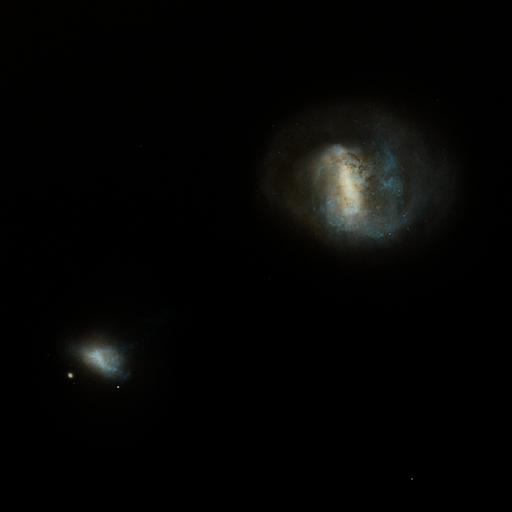
- Designation/s – Large Magellanic Cloud (LMC), Small Magellanic Cloud (SMC)
- Type – Irregular Galaxies/ Magellanic Spiral Galaxies (Sm)
- Constellation – Dorado/Mensa (LMC), Tucana/Hydrus (SMC)
- Apparent Magnitude – 0.9 (LMC), 2.7 (SMC)
- Size – ~14,000 light-years (LMC), ~7,000 light-years (SMC)
- Distance – ~160,000 light-years, ~200,000 light-years
The Magellanic Clouds are a pair of galaxies that are satellites of the Milky Way. As companion galaxies, they orbit around the Milky Way. It is composed of the Large Magellanic Cloud (LMC) and the Small Magellanic Cloud (SMC).
Both the LMC and the SMC are considered irregular galaxies because they have no definite shape. There are some hints of a bar structure in the LMC which indicates that it may have been a barred spiral once.
Now, it has only one spiral arm. Because of this, it became the prototype of the Magellanic spiral galaxy. That said, these galaxies are classified as irregular and spiral galaxies.
The Milky Way’s influence is thought to be responsible for the disrupted form of these companion galaxies.
NGC 5477
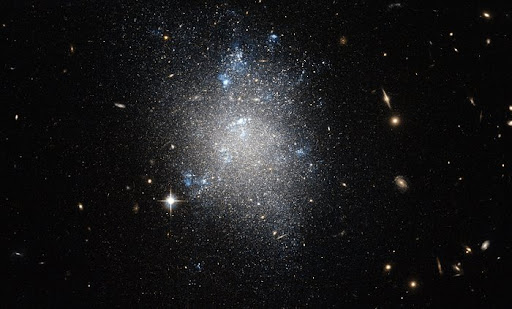
- Designation/s – NGC 5477
- Type – Dwarf Irregular Galaxy
- Constellation – Ursa Major
- Apparent Magnitude – 14.01
- Distance – ~20 million light-years
NGC 5477 is a dwarf galaxy with no defined shape. It is located in the Ursa Major constellation, the Great Bear. It was discovered in 1789 by William Herschel. This irregular galaxy shows signs of star formation, with hydrogen gas all around.
IC 4710
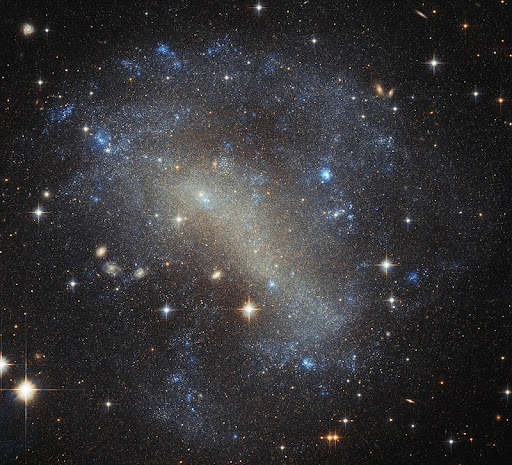
- Designation/s – IC 4710
- Type – Irregular Galaxy
- Constellation – Pavo
- Apparent Magnitude – 11.9
- Distance – ~34 million light-years
IC 4710 is a dwarf galaxy located in the direction of the southern sky constellation of Pavo the Peacock. As with other irregular galaxies, it has a rather scattered and chaotic shape. The bright stars in the edges of this galaxy, however, are signs of star birth. It lies around 34 light-years from the solar system.
Sagittarius Dwarf Irregular Galaxy – SagDIG
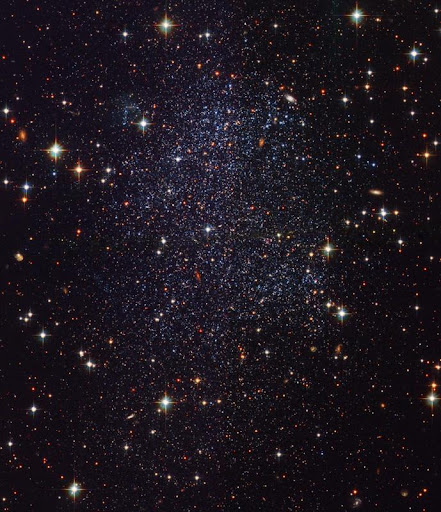
- Designation/s – Sagittarius Dwarf Irregular Galaxy
- Type – Dwarf Irregular Galaxy
- Constellation – Sagittarius Constellation
- Apparent Magnitude – 15.5
- Distance – ~3.3 million light-years
The Sagittarius Dwarf Irregular Galaxy is a galaxy in the Local Group. This galaxy lies around 3.3 million light-years away. The stars in this irregular galaxy are mostly young, but some are metal-poor.
Types Of Galaxies – Other Classifications
Galaxies come in all shapes and sizes, so there will always be many of them that will not fit the common four galaxy types. The wonders of the universe never fail to surprise us as scientists discover more and more of these objects. Below are other galaxy types you might have heard of.
Lenticular Galaxies
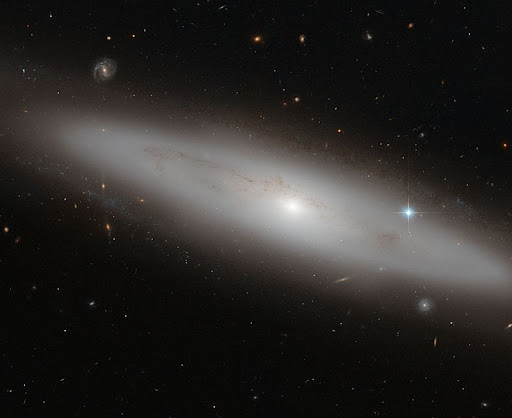
Lenticular galaxies are lens-like in shape, that is why they are given this classification. Galaxies of this type are said to be intermediate between a spiral and an elliptical galaxy. What this means is that it has a large disk but without spiral arms.
Starbirth on galaxies of this type is minimal as they have already used up their interstellar materials. As a result, the star population in lenticular galaxies is mostly composed of older stars.
Peculiar Galaxies
Peculiar galaxies are a class of their own. These are totally unique-looking galaxies with unusual characteristics. Much of these peculiarities are a result of interactions with other galaxies.
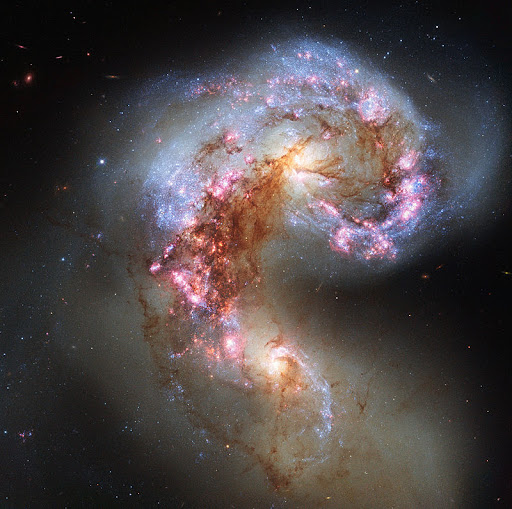
The Antennae Galaxies are an example of a peculiar galaxy pair. These two interacting galaxies have disrupted each other’s shape. With the combination of their materials, the dust and gas caused more star formation.
The collision of the Antennae Galaxies will result in their nuclei combining. They will join together to become a bigger galaxy. Scientists think that the same way will happen with the Milky Way and the Andromeda Galaxy in the far future.
Whirlpool galaxy
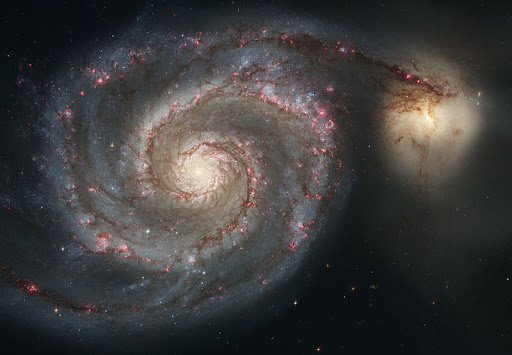
Though its shape is not disrupted, the Whirlpool Galaxy, which is a spiral-type, is also interacting with a smaller galaxy called NGC 5195.
Hoag’s object
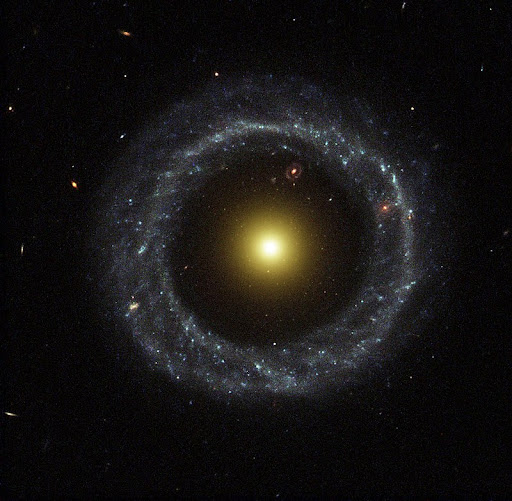
There is also a weird type of galaxy called a ring galaxy. A perfect example of this type is Hoag’s object. Theories on the formation of these galaxies include accretion of material and galactic collisions.
Summary: Features of the Different Types Of Galaxy
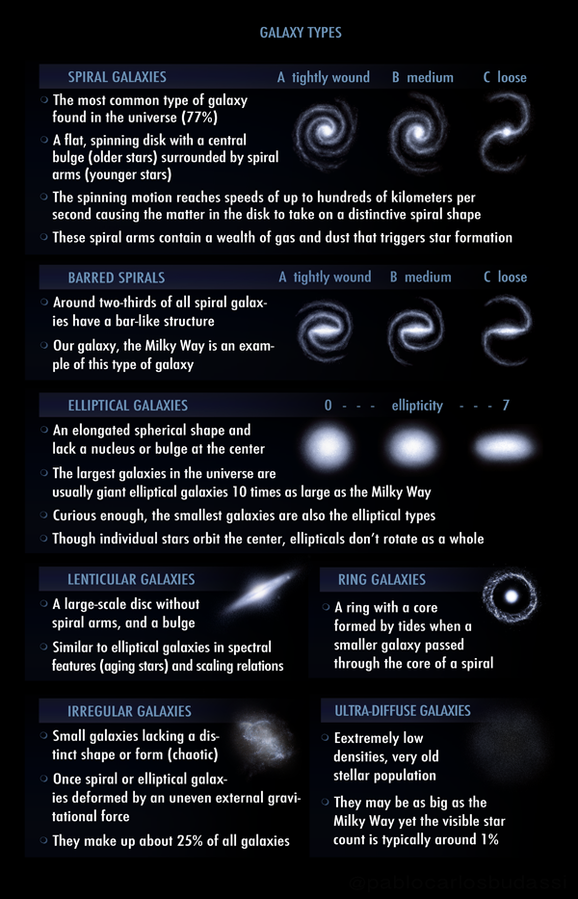
Types Of Galaxies – Frequently Asked Questions
Which type of galaxy is the Milky Way?
The Milky Way is a barred spiral galaxy. It has a central bar and four major spiral arms. There are also smaller arms called spurs.
Which type of galaxy is Andromeda?
The Andromeda Galaxy is a large spiral galaxy. It has two continuous arms that are trailing around it. In its center is a supermassive black hole. Blue and red stars are present in this galaxy. It is also surrounded by a dust ring.
How many galaxies are there?
The universe is a very big place and there is much of it that we cannot see. Estimates show that there are about two trillion galaxies in the observable universe.
Which galaxies can we see with the naked eye?
The limiting magnitude with which we can see celestial objects with the naked eye is around 6.5. With that said, under a dark sky and good weather conditions we can see the following galaxies:
- Milky Way
- Large Magellanic Cloud
- Small Magellanic Cloud
- Andromeda Galaxy
- Triangulum Galaxy
How old is the Milky Way?
The Milky Way is estimated to be around 13.6 billion years old. In contrast, the Universe is thought to be around 13.8 years old. That means, our own galaxy started forming in the early universe.
Types Of Galaxies – Sources:
https://spaceplace.nasa.gov/galaxy/en/
https://svs.gsfc.nasa.gov/11534
(https://earthsky.org/clusters-nebulae-galaxies/what-is-the-local-group/)
https://www.nationalgeographic.com/science/article/galaxies
https://apod.nasa.gov/apod/ap180927.html
https://www.nasa.gov/feature/goddard/2017/messier-63-the-sunflower-galaxy
https://www.nasa.gov/feature/goddard/2017/messier-104-the-sombrero-galaxy
https://www.nasa.gov/feature/messier-109/
https://futurism.com/ic-1101-the-largest-galaxy-ever-found
https://esahubble.org/images/potw1921a/
https://hubblesite.org/contents/news-releases/2012/news-2012-38.html
https://apod.nasa.gov/apod/ap100309.html
https://en.wikipedia.org/wiki/Messier_49
https://esahubble.org/images/potw1301a/
https://hubblesite.org/science/galaxies
Types Of Galaxies – Image Sources:
What is a galaxy? (Andromeda galaxy) : https://upload.wikimedia.org/wikipedia/commons/thumb/8/8c/Andromeda_Galaxy_560mm_FL.jpg/1280px-Andromeda_Galaxy_560mm_FL.jpg
Abell 2218 galaxy cluster: https://cdn.spacetelescope.org/archives/images/screen/heic0814a.jpg
Milky Way Galaxy illustration: https://www.nasa.gov/sites/default/files/styles/full_width/public/thumbnails/image/1-milky-way-map-16.jpg?itok=bjGPVlRo
Our place in the Milky Way: https://spaceplace.nasa.gov/galaxy/en/solaraddress.en.png
Hubble Classification scheme: https://upload.wikimedia.org/wikipedia/commons/2/21/HubbleTuningFork.jpg
Hubble–de Vaucouleurs Galaxy Morphology Diagram: https://upload.wikimedia.org/wikipedia/commons/thumb/8/85/Hubble_-_de_Vaucouleurs_Galaxy_Morphology_Diagram.png/1280px-Hubble_-_de_Vaucouleurs_Galaxy_Morphology_Diagram.png
Galaxy formation: https://svs.gsfc.nasa.gov/11534
Types of galaxies: https://hubblesite.org/files/live/sites/hubble/files/home/science/galaxies/_images/STScI-H-galaxies-3types-2400×1200.jpg
Spiral galaxy (Messier 74): https://upload.wikimedia.org/wikipedia/commons/thumb/d/d0/PESSTO_Snaps_Supernova_in_Messier_74.jpg/800px-PESSTO_Snaps_Supernova_in_Messier_74.jpg
Andromeda galaxy: https://upload.wikimedia.org/wikipedia/commons/thumb/5/58/Andromeda_Galaxy.jpg/1024px-Andromeda_Galaxy.jpg
Pinwheel galaxy: https://upload.wikimedia.org/wikipedia/commons/thumb/c/c5/M101_hires_STScI-PRC2006-10a.jpg/1024px-M101_hires_STScI-PRC2006-10a.jpg
Triangulum galaxy: https://apod.nasa.gov/apod/image/1809/M33_15x480s_CDK14_D810A_ps13-ap1024.jpg
Sunflower galaxy: https://upload.wikimedia.org/wikipedia/commons/thumb/e/e3/A_galactic_sunflower.jpg/800px-A_galactic_sunflower.jpg
Sombrero galaxy: https://upload.wikimedia.org/wikipedia/commons/thumb/5/5e/M104_ngc4594_sombrero_galaxy_hi-res.jpg/800px-M104_ngc4594_sombrero_galaxy_hi-res.jpg
Barred spiral galaxy (NGC 1300) : https://upload.wikimedia.org/wikipedia/commons/thumb/5/52/Hubble2005-01-barred-spiral-galaxy-NGC1300.jpg/800px-Hubble2005-01-barred-spiral-galaxy-NGC1300.jpg
NGC 1300: https://stsci-opo.org/STScI-01EVT8DJEDWP6XH4S8WZZB8FVB.png
Messier 109: https://upload.wikimedia.org/wikipedia/commons/thumb/5/57/Messier-109-NGC-3992.jpg/450px-Messier-109-NGC-3992.jpg
NGC 4921: https://upload.wikimedia.org/wikipedia/commons/thumb/6/68/NGC_4921_by_HST.jpg/800px-NGC_4921_by_HST.jpg
NGC 1073: https://www.nasa.gov/images/content/620904main_hubble-20120206_946-710.jpg
Elliptical galaxy (IC 2006): https://upload.wikimedia.org/wikipedia/commons/thumb/8/80/Elliptical_galaxy_IC_2006.jpg/800px-Elliptical_galaxy_IC_2006.jpg
IC 1101: https://upload.wikimedia.org/wikipedia/commons/f/fd/IC_1101_in_Abell_2029_%28hst_06228_03_wfpc2_f702w_pc%29.jpg
Messier 59: https://cdn.spacetelescope.org/archives/images/thumb700x/potw1921a.jpg
Messier 60: https://upload.wikimedia.org/wikipedia/commons/thumb/2/2a/Messier_60_-_Hubble_%282013-9-24%29.jpg/800px-Messier_60_-_Hubble_%282013-9-24%29.jpg
Maffei 1: https://upload.wikimedia.org/wikipedia/commons/0/0c/Maf1atlas.jpg
Messier 49: https://upload.wikimedia.org/wikipedia/commons/thumb/4/4d/Noao-m49.tif/lossy-page1-800px-Noao-m49.tif.jpg
Irregular Galaxy (UGC 4459) : https://www.nasa.gov/sites/default/files/styles/full_width_feature/public/thumbnails/image/hubble_friday_04012016.jpg
Magellanic Clouds: https://upload.wikimedia.org/wikipedia/commons/thumb/8/8a/Smclmc-35deg-16ks8k-min20k-4550k-m19-s1-s8.png/800px-Smclmc-35deg-16ks8k-min20k-4550k-m19-s1-s8.png
NGC 5477: https://cdn.spacetelescope.org/archives/images/thumb700x/potw1301a.jpg
IC 4710: https://upload.wikimedia.org/wikipedia/commons/thumb/7/7e/A_frenzy_of_stars_IC_4710.jpg/800px-A_frenzy_of_stars_IC_4710.jpg
Sagittarius Dwarf irregular galaxy: https://upload.wikimedia.org/wikipedia/commons/4/48/SagDIG.jpg
NGC 4866: https://upload.wikimedia.org/wikipedia/commons/thumb/9/92/NGC_4866_as_imaged_by_Hubble.jpg/800px-NGC_4866_as_imaged_by_Hubble.jpg
Antennae Galaxies (Credit: NASA, ESA, and the Hubble Heritage Team (STScI/AURA)-ESA/Hubble Collaboration): https://upload.wikimedia.org/wikipedia/commons/thumb/3/30/Antennae_Galaxies_reloaded.jpg/800px-Antennae_Galaxies_reloaded.jpg
Whirlpool galaxy: https://upload.wikimedia.org/wikipedia/commons/thumb/d/db/Messier51_sRGB.jpg/800px-Messier51_sRGB.jpg
Hoag’s object: https://upload.wikimedia.org/wikipedia/commons/thumb/d/da/Hoag%27s_object.jpg/800px-Hoag%27s_object.jpg
Galaxy types in summary: https://upload.wikimedia.org/wikipedia/commons/thumb/4/45/Galaxy_types_summary.png/578px-Galaxy_types_summary.png